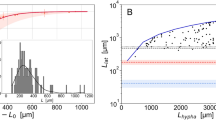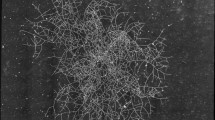Abstract
We consider a model for the morphology and growth of the fungus-like plant pathogen Phytophthora using the example of Phytophthora plurivora. Here, we are utilizing a correlated random walk describing the density of tips. This random walk incorporates a delay in branching behavior: newly split tips only start to grow after a short while. First, we question the effect of such a delay on the running fronts, for uniform- as well as non-uniform turning kernels. We find that this delay primarily influences the slope of the front and therewith the way of spatial appropriation, and not its velocity. Our theoretical predictions are confirmed by the growth of Phytophthora in concrete experiments performed in Petri dishes. The second question addressed in this paper, concerns the manner tips are interacting, especially the point why tips stop to grow “behind” the interface of the front, respectively in confrontation experiments at the interface between two colonies. The combination of experimental data about the spatially structured time course of the glucose concentration and simulations of a model taking into account both, tips and glucose, reveals that nutrient depletion is most likely the central mechanism of tip interaction and hyphal growth inhibition. We presume that this is the growing mechanism for our kind of Phytophthora in infected plant tissue. Thus, the pathogen will sap its hosts via energy depletion and tissue destruction in infected areas.
Similar content being viewed by others
References
Abramoff MD, Magelhaes PJ, Ram SJ (2004) Image processing with ImageJ. Biophot Int 11: 36–42
Apel H, Paudyal MS, Richter O (2002) Population dynamics and treatment strategies of Phytophthora infestans (late blight) in the Mid-Hills of Nepal. Landschaftsökologie und Umweltforschung 38: 1–12
Brown AV, Brasier CM (2007) Colonization of tree xylem by Phytophthora ramorum, P. kernoviae and other Phytophthora species. Plant Pathol 56: 227–241
Cahill DM, Bennett IJ, McComb JA (1993) Mechanisms of resistance to Phytophthora cinnamomi in clonal, micropropagated Eucalyptus marginata. Plant Pathol 42: 865–872
Cahill DM, Rookes JE, Wilson BA, Gibson L, McDougall KL (2008) Phytophthora cinnamomi and Australia’s biodiversity: impacts, predictions and progress towards control. Aust J Bot 56: 279–310
Clemenz C, Fleischmann F, Häberle K-H, Matyssek R, Osswald W (2008) Photosynthetic and leaf water potential responses of Alnus glutinosa to stem-base inoculation with Phytophthora alni subsp alni. Tree Physiol 28: 1703–1711
Codling EA, Plank MJ, Benhamou S (2008) Random walk models in biology. J R Soc Interface 5: 813–834
Davidson FA, Sleeman BD, Rayner ADM, Crawford JW, Ritz K (1997) Travelling waves and pattern formation in a model for fungal development. J Math Biol 35: 589–608
Davidson FA, Boswell GP, Fischer MWF, Heaton L, Hofstadler D, Roper M (2011) Mathematical modelling of fungal growth and function. IMA Fungus 2: 33–37
Davis MHA (1984) Piecewise-deterministic Markov processes: a general class of non-diffusion stochastic models. J R Stat Soc B 46: 353–388
Edelstein-Keshet L, Ermentrout B (1989) Models for branching networks in two dimensions. SIAM J Appl Math 49(4): 1136–1157
Erwin D, Ribeiro O (1996) Phytophthora diseases world-wide. APS Press, St. Paul
Fleischmann F, Schneider D, Matyssek R, Osswald WF (2002) Investigations on net CO2 assimilation, transpiration and root growth of Fagus sylvatica infested with four different Phytophthora species. Plant Biol 4: 144–152
Fleischmann F, Gottlein A, Rodenkirchen H, Lutz C, Osswald WF (2004) Biomass, nutrient and pigment content of beech (Fagus sylvatica) saplings infected with Phytophthora citricola, P. cambivora, P. pseudosyringae and P. undulata. For Pathol 34: 79–92
Fleischmann F, Koehl J, Portz R, Beltrame AB, Osswald WF (2005) Physiological change of Fagus sylvatica seedlings infected with Phytophthora citricola and the contribution of its elicitin “Citricolin” to pathogenesis. Plant Biol 7: 650–658
Fleischmann F, Raidl S, Osswald WF (2010) Changes in susceptibility of beech (Fagus sylvatica) seedlings towards Phytophthora citricola under the influence of elevated atmospheric CO2 and nitrogen fertilization. Environ Poll 158: 1051–1060
Fry WE, Apple AE, Bruhn JA (1983) Evaluation of potato late blight forecasts modified to incorporate host resistance and fungicide weathering. Phytopathology 73(7): 1054–1059
Griffin DH (1994) Fungal physiology, 2nd edn. Wiley, New York
Hadeler KP (1994) Travelling fronts for correlated random walks. Can Appl Math Quart 2: 27–43
Hadeler KP (1999) Reaction transport systems. In: Capasso V, Diekmann O (eds) Mathematics inspired by biology. CIME Lectures 1997, Florence. Lecture notes in mathematics, vol 1714. Springer, New York, pp 95–150
Hansen EM (2008a) Alien forest pathogens: Phytophthora species are changing world forests. Boreal Environ Res 13(Suppl A):33–41
Hansen EM (2008b) A historical review of Phytophthora diseases. Phytopathol 98: S196
Harwood TD, Xub X, Pautassoc M, Jegerc MJ, Shawa MW (2009) Epidemiological risk assessment using linked network and grid based modelling: Phytophthora ramorum and Phytophthora kernoviae in the UK. Ecol. Model 220: 3353–3361
Hillen Th, Othmer HG (2001) The diffusion limit of transport equations derived from velocity-jump processes. SIAM J Appl Math 61: 751–775
Jung T (2009) Beech decline in Central Europe driven by the interaction between Phytophthora infections and climatic extremes. For Pathol 39: 73–94
Jung T, Burgess TI (2009) Re-evaluation of Phytophthora citricola isolates from multiple woody hosts in Europe and North America reveals a new species, Phytophthora plurivora sp nov.. Persoonia 22: 95–110
Lax P (2002) Functional analysis. Interscience series in pure and applied mathematics. Wiley, Chichester
Matsunaga T, Karube I, Suzuki S (1980) Some observations on immobilized hydrogen-producing bacteria: behavior of hydrogen in gel membranes. Biotechnol Bioeng 22: 2607–2615
Meskauskas A, McNulty LJ, Moore D (2004) Concerted regulation of all hyphal tips generates fungal fruit body structures: experiments with computer visualizations produced by a new mathematical model of hyphal growth. Mycol Res 108: 341–353
Moslonka-Lefebvre M, Pautasso M, Jeger MJ (2009) Disease spread in small-size directed networks: epidemic threshold, correlation between links to and from nodes, and clustering. J Theor Biol 260: 402–411
Ndeffo Mbah ML, Gilligan ChA (2010) Optimization of control strategies for epidemics in heterogeneous populations with symmetric and asymmetric transmission. J Theor Biol 262: 757–763
Othmer HG, Stevens A (1997) Aggregation, blowup and collapse: the ABC’s of taxis and reinforced random walks. SIAM J Appl Math 57: 1044–1081
Pinzón A, Barreto E, Bernal A, Achenie L, Barrios AFG, Isea R, Restrepo S (2009) Computational models in plant-pathogen interactions: the case of Phytophthora infestans. Theor Biol Med Model 6: 24
Plank MJ, Sleeman DB (2004) Lattice and non-lattice models of tumour angiogenesis. Bull Math Biol 66: 1785–1819
Portz RL, Fleischmann F, Koehl J, Fromm J, Ernst D, Pascholati SF, Osswald WF (2011) Histological, physiological and molecular investigations of Fagus sylvatica seedlings infected with Phytophthora citricola. For Pathol. doi:10.1111/j.1439-0329.2010.00667.x
Schwetlick HR (2000) Travelling fronts for multidimensional nonlinear transport equations. Ann Inst Henri Poincaré Analyse non linéaire 17: 523–550
Schwetlick HR (2005) Uniqueness of travelling fronts for bistable nonlinear transport equations. Bath Institute for Complex Systems. Preprint 13/05
Skelsey P, Kessel GJT, Rossing WAH, van der Werf W (2009) Parameterization and evaluation of a spatiotemporal model of the potato late blight pathosystem. Anal Theor Plant Pathol 99: 290–300
Smith JH (1924) On the early groth rate of the individual fungus hypha. New Pathologist 24: 65–78
Spanu P, Kämper J (2010) Genomics of biotrophy in fungi and oomycetes—emerging patterns. Curr Opin Plant Biol 13: 409–414
Thines M, Kamoun S (2010) Oomycete–plant coevolution: recent advances and future prospects. Curr Opin Plant Biol 13: 427–433
Thomas FM, Blank R, Hartmann G (2002) Abiotic and biotic factors and their interactions as causes of oak decline in Central Europe. For Pathol 32: 277–307
van Oijen M (1992) Selection and use of a mathematical model to evaluate components of resistance to Phytophthora infestans in potato. Neth J Plant Pathol 98: 192–202
Walther Th, Reinsch H, Ostermann K, Deutsch A, Bley Th (2011) Applying dimorphic yeasts as model organisms to study mycelial growth: part 2. Use of mathematical simulations to identify different construction principles in yeast colonies. Bioprocess Biosyst Eng 34: 21–31
Weiland JE, Nelson AH, Hudler GW (2010) Aggressiveness of Phytophthora cactorum, P. citricola I, and P. plurivora from European Beech. Plant Dis 94: 1009–1014
Zeidler E (1993) Nonlinear functional analysis and its applications I (Fixed-points theorems). Springer, Berlin
Author information
Authors and Affiliations
Corresponding author
Rights and permissions
About this article
Cite this article
Henkel, A., Müller, J. & Pötzsche, C. Modeling the spread of Phytophthora . J. Math. Biol. 65, 1359–1385 (2012). https://doi.org/10.1007/s00285-011-0492-7
Received:
Revised:
Published:
Issue Date:
DOI: https://doi.org/10.1007/s00285-011-0492-7




